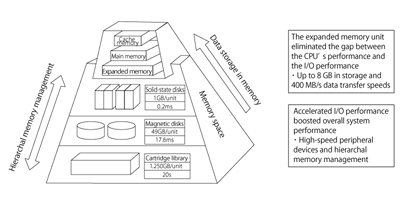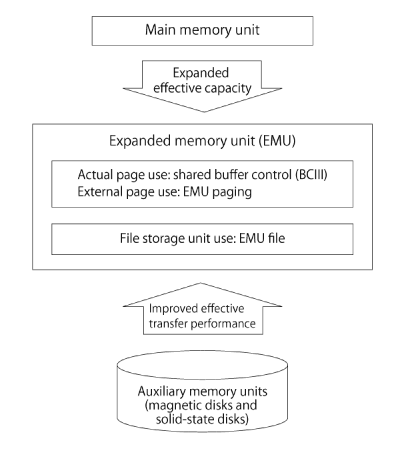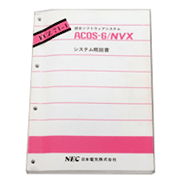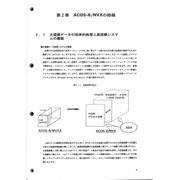NEC announced the ACOS-6/NVX (which stood for “new virtual extended”) operating system for its large mainframes in March 1991 and began shipping the operating system in March 1992. While maintaining backward compatibility with the earlier ACOS-6/MVX and ACOS-6/MVXII large mainframe operating systems, ACOS-6/NVX provided greater extensibility and reliability for the new ACOS extended system architecture that was developed for the System 3900, which began shipping in tandem with ACOS-6/NVX. The new architecture enabled efficient processing of massive amounts of data by including an extended data space and supporting an expanded memory unit that complemented the main memory unit. ACOS-6/NVX was installed on System 3900 and System 3700 machines.
The new architecture and main operating system functions had the following characteristics.
1. Features of the new architecture
- (1) Extended system architecture
- The extended system architecture came with a main memory unit, with up to 1 GB of storage, and an expanded memory unit (EMU), with up to 8 GB of storage, as well as a large-capacity high-performance solid-state disk unit and a magnetic disk unit, and provided an extended data space — a 4 petabyte addressable space — that made efficient use of these memory units for the processing of massive amounts of data. These innovations gave the architecture the necessary specifications and performance to meet the needs of large-scale online transaction systems and large-scale data servers that were the core of 1990s corporate information systems.
2. Operating system features
- (1) Enhanced relational database functions
- ACOS-6/NVX provided the RIQSII V2 high-performance relational database system with dramatically improved specifications, more storage modes, and a beefed-up high-speed SQL engine compared to the relational information query system (RIQS), which was inheritable from ACOS-6/MVX.
(2) Support for connections with open systems
In response to the increase in demand for connections to UNIX systems in distributed computing environments, ACOS-6/NVX provided a virtual TCP/IP terminal function (telnet), a file transfer function (ftp), a job transfer function (NQS), a file server function, and a print server function. The operating system also provided file transfer access (FTAM) in the international OSI standard protocol and an e-mail function (MOTIS/MHS).
(3) Support for high operability and high availability
To lower operating costs while expanding the system, ACOS-6/NVX provided unified storage management (USM), which made the management of file units more efficient, and automatic operation system (AOS), which automated the operation of distributed systems.
And as far as high redundancy and high reliability technologies that are the cornerstones of continuous-operating systems, NEC, with the ACOS-6/NVX and System 3900, put together a collection of RAS (reliability, availability, and serviceability) technologies such as multi-system RAS facility (MSRF) — a hot standby system, dual volume facility (DVF) — which realized disk redundancy in software, and processor relief.
(4) Support for high productivity
To keep down rising application development costs, ACOS-6/NVX provided a number of software development assistance systems — such as STEPSII (Standardized Technology and Engineering for Programming Support II), a development methodology, EWS CASE, which visualizes all steps from analysis and design to programming, and SOFPIA (Software Productivity Improvement Aid), which improves the productivity, maintainability, and reliability of program development — to improve the productivity throughout the software lifecycle.





